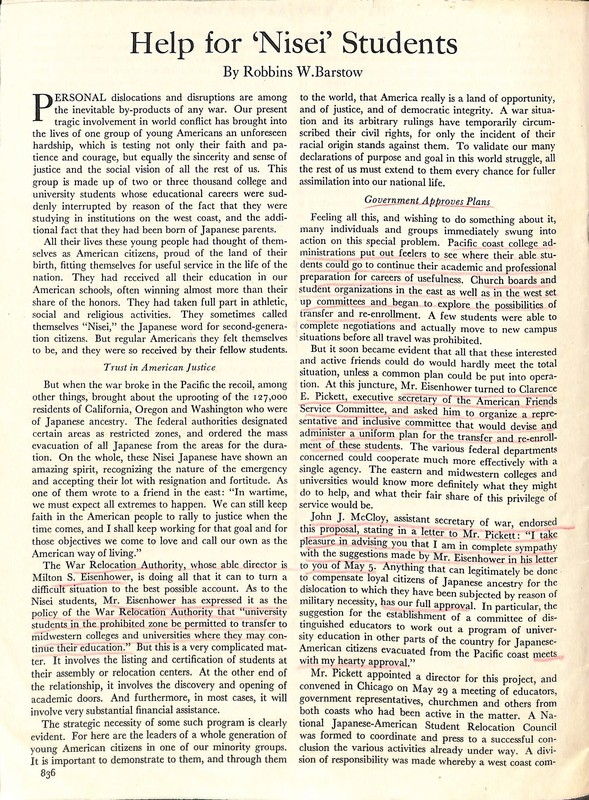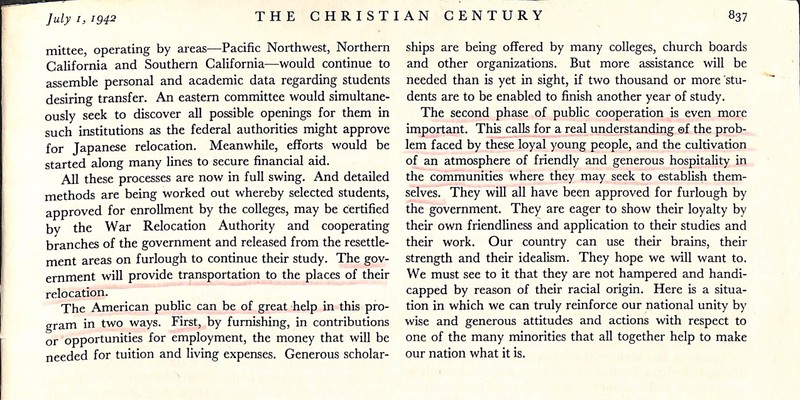Conclusion
Introduction
Text-to-speech Audio
The “Battle of Parkville” reflected complex national sentiments that surrounded the incarceration of Japanese Americans and anti-Japanese sentiments during World War II. The extensive support that Park College received, in a community without much exposure to Japanese Americans, served as a surprise. While opposition occurred, it often reflected a long-standing national anti-Japanese narrative exacerbated by wartime fervor. Furthermore, how Americans voiced their opinions locally and nationally demonstrated acceptable language and thoughts of the time.
Images
"Help for 'Nisei' Students," July 1, 1942, The Christian Century, Page 1.

"Help for 'Nisei' Students," July 1, 1942, The Christian Century, Page 2.

Backstory and Context
Text-to-speech Audio
"American perceptions of the Chinese and Japanese can change between perilous threat and paternalistic ward in relation to U.S. perspectives, beliefs, and current interests..." (Seto 57).
From radio personnel incorporating racially insensitive words into their broadcasts, to white Americans addressing Japanese Americans and the Japanese in racially offensive terms in correspondence, blatant anti-Japanese racism persisted throughout the war. Although fear and anger from the war influenced the sheer acceptance of terminology and sentiments in personal and public opinion, it was far from a newly developed concept in the United States. Thus, a purveying anti-Japanese sentiment, based in early 20th century arguments of assimilability and American superiority, rested in American society. Such sentiments re-emerged during crises, such as the success of Japan in the Russo-Japanese War, Japanese Imperial power and the attack on Pearl Harbor during World War II, and even the fear of Japanese-made goods in the 1980s. Blatant wartime racism was fueled by this inherent anti-Japanese sentiment that maintained a foothold in the 20th century.
Both Japanese Americans and the people of Japan suffered from “othering” by the American people. While “othering” of Japanese nationals increased due to wartime mindsets against an opposing nation, Japanese Americans experienced “othering” due to racial prejudice among white Americans. Japanese American loyalty constantly fell under scrutiny due to their Japanese heritage. Even Americans who supported Nisei students and considered Japanese Americans loyal citizens projected prejudices that permeated American society. While many Americans may not have intended to harm Japanese Americans through their prejudice, the “othering” of Japan and Japanese Americans harmed an entire demographic in the United States throughout the duration of the war.
From local perceptions of Nisei students in Parkville, Missouri, to nationally broadcast radio personality’s opinions, the perpetuation of anti-Japanese sentiment during World War II was highly pervasive. However, opinions held on Japanese Americans as compared to the Japanese people seemed more diverse and complex. Nonetheless, this did not lessen the racial hatred that was present among Americans within the United States and abroad. The support for Nisei student admittance at Park College by a community with little contact with Japanese American communities offers that nationally ingrained ideals do not always dictate the outcome of societal decisions. Nevertheless, this does not negate the long-standing anti-Japanese sentiments that have plagued American society. Racial hatred could be perpetuated by misinformation, generalizations, or seemingly harmless comments that demonstrate signs of prejudice. The active decision to address and move past ingrained prejudice, while supporting those who have been discriminated against within society, can lead to progress.
Sources
Daniels, Roger. Asian America: Chinese and Japanese in the United States Since 1850. Seattle: University of Washington Press, 1988.
Dower, John W. War without Mercy: Race and Power in the Pacific War. Pantheon Books, 1986.
Hayashi, Brian Masaru. Democratizing the Enemy: The Japanese American Internment. Princeton, N.J.: Princeton University Press, 2008.
Ito, Leslie A. “Japanese American Women and the Student Relocation Movement, 1942-1945.” Frontiers: A Journal of Women Studies 21, no. 3 (2000): 1–24. https://doi.org/10.2307/3347107.
Kurashige, Lon. Two Faces of Exclusion: The Untold History of Anti-Asian Racism in the United States. Chapel Hill: The University of North Carolina Press, 2016.
Seto, Brandon P. “Paternalism and Peril: Shifting U.S. Racial Perceptions of the Japanese and Chinese Peoples from World War II to the Early Cold War.” Asia Pacific Perspectives 13, no. 1 (2015): 57–78
"Help for 'Nisei' Students," July 1, 1942, The Christian Century. Located in Francis Fishburn Archives and Special Collections, Park University Nisei Collection, Park University, Parkville, MO, ID#PC-M-1942.1.166. https://www.jstor.org/stable/community.33005499?searchText=&searchUri=%2Fsite%2Fpark%2Farchives%2F1942-34139899%2F%3FsearchUri%3D%252Fsite%252Fpark%252Farchives%252Fparkuniversityniseicollection-33293307%252F%253Fsearchkey%253D1681223413361%2526doi%253D10.2307%25252Fcontainer.34139901%26ab_segments%3D0%252Fbasic_search_gsv2%252Fcontrol%26searchkey%3D1681223521160&ab_segments=0%2Fbasic_search_gsv2%2Fcontrol&searchKey=&refreqid=fastly-default%3A0e6f73bcec68f34c18a9d2f25aa6ad30&seq=2
"Help for 'Nisei' Students," July 1, 1942, The Christian Century. Located in Francis Fishburn Archives and Special Collections, Park University Nisei Collection, Park University, Parkville, MO, ID#PC-M-1942.1.166. https://www.jstor.org/stable/community.33005499?searchText=&searchUri=%2Fsite%2Fpark%2Farchives%2F1942-34139899%2F%3FsearchUri%3D%252Fsite%252Fpark%252Farchives%252Fparkuniversityniseicollection-33293307%252F%253Fsearchkey%253D1681223413361%2526doi%253D10.2307%25252Fcontainer.34139901%26ab_segments%3D0%252Fbasic_search_gsv2%252Fcontrol%26searchkey%3D1681223521160&ab_segments=0%2Fbasic_search_gsv2%2Fcontrol&searchKey=&refreqid=fastly-default%3A0e6f73bcec68f34c18a9d2f25aa6ad30&seq=2
